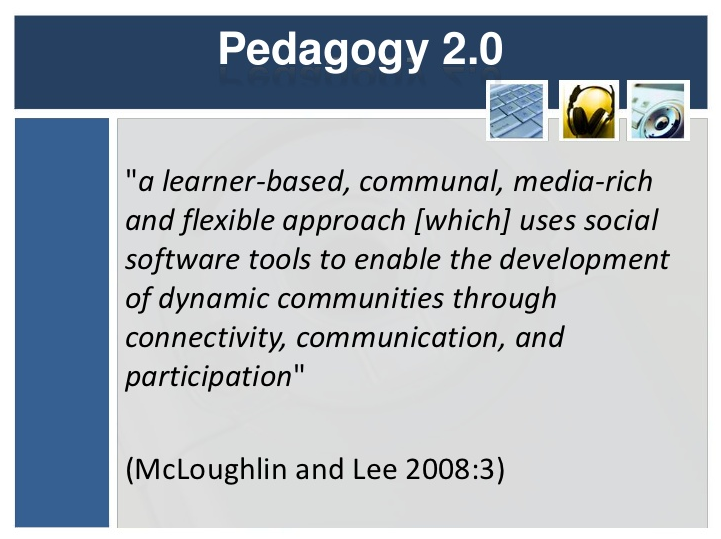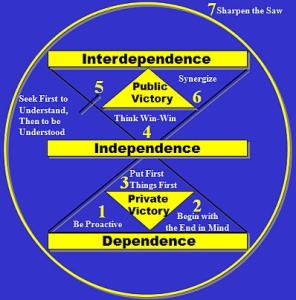The Social Web
One of the core readings this week, Future Learning Landscapes: Transforming Pedagogy through Social Software by McLoughlin and Lee (2008), highlights the challenges of integrating social software tools into learning environments. Social learning is an ideal that strongly resonates with me. Indeed, my PLE demonstrates the emphasis I place on human interaction for learning.
Three Fundamental Changes in Learning
McLoughlin and Lee discuss a paradigm shift in terms of our conceptualisation of teaching and learning:
(i) teacher-centred > student-centred
(ii) formal > informal learning
(iii) textbook fixed-content > open-source and open-content.
These sentiments are shared by Bibblio CEO Mads Holmen in a recent talk about the relationship between Education and Learning.
Pedagogy 2.0
From the changes in attitude outlined above, we can see that technology is influencing individuals in new and different ways, allowing them to “… contribute, communicate, and collaborate using a variety of tools that empower them to develop and share ideas”. The article goes on to suggest how to harness the power of the internet to match the needs of students. “Tools like blogs, wikis, media-sharing applications, and social networking sites can support and encourage informal conversation, dialogue, collaborative content generation, and knowledge sharing, giving learners access to a wide range of ideas and representations.” In terms of ‘personal publishing’ (Downes 2004, 18) I do write a blog, but it occurs to me now that I have not invited others to follow me and make comments. In this way, I am missing out on the opportunity of dynamic, peer-to-peer learning. A near-future aim is to promote my blog and invite others join in my/their learning process.
Connectivism and Interdependence
Connectivism, the process of creating a network of personal knoweldge, leads to interdependence, sharing ideas and learning from others. It is “…a world that links minds, communities and ideas while promoting personalization, collaboration, and creativity leading to knowledge creation”. The idea of interdependence brought up in the article reminds me of Steven Covey’s work The Seven Habits of Highly Effective People (1989). Covey sees the three main transformations of life being dependence (a child is dependent on a parent), indepdence (self-mastery) and interdependence (working with others), in that order. “Certainly, independence is vital; however, the problem is that we live in an interdependent reality. Our most important work, the problems we hope to solve or the opportunities we hope to realize require working and collaborating with other people in a high-trust, synergistic way—whether at home or at work. Having an interdependent mindset, skills and tools are vital, especially now as we work through challenges unlike anything most of us have ever seen in our life time.” (http://www.stephencovey.com/blog/?tag=interdependence).
Challenges facing Pedagogy 2.0
– check validity, reliability, accuracy
It is true that, “not all student-generated content, even if creative or innovative, will be valid and reliable”. Being ‘digitally wise’ (Prensky, 2011), and having the ability to select appropriate and relevant materials are imperative in order to “…navigate and use the overabundance of information available, including the skills to locate quality sources and assess them for obejectivity, reliablity and currency (Katz and Maclin 2007).”
– understand your learners interests
I agree with the article’s central tenet – that (understanding) the process of learning is just as important as what is learnt, and therefore we should not confine ourselves to textbooks or classrooms, but should be willing to learn in any environment, “The textbook content is the external body of knowledge; the student performance content is the content that shapes and molds the learner’s unique knowledge structures”.
– understand your learners (digital) needs
Teachers need to be aware of their learners (and their own) digital skills. It is not as simple as ‘digital natives, digital immigrants’ (Prensky, 2001). Also there may be confusion and misunderstanding when social software that was previously used for social interaction, is used for educational interaction. “Further, students may percieve instructors’ attempts to coopt such social technologies for educational purposes as intrusions into their space”.
– make learners aware of copyright issues, and respect ownership, and intellectual property rights
My Key Learning/’Take-Away’ for employing social software in teaching:
Apart from making a contigency plan to deal with the challenges above, I would like to add that teachers must also
– give guidance and scaffolding, “The challenge is to enable self-direction, knowledge building, and learner control by offering flexible options for students to engage in learning that is authentic and relevant to their needs and to those of the networked society while still providing necessary structure and scaffolding”.
References
Future Learning Landscapes: Transforming Pedagogy through Social Software, McLoughlin and Lee, 2008
From Digital Natives to Digital Wisdom, Prensky 2001
Digital Natives, Digital Immigrants, Prensky, 2011



